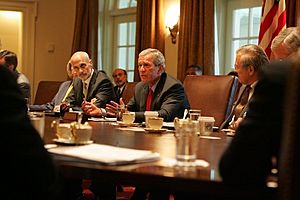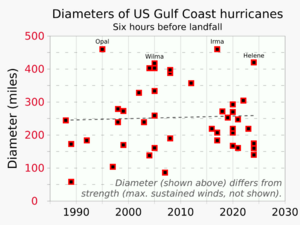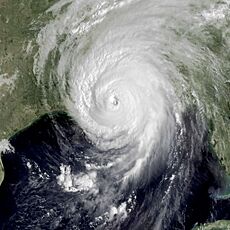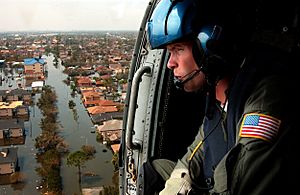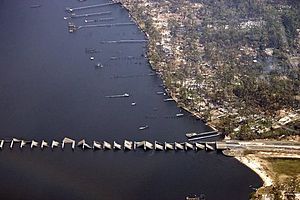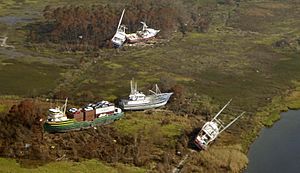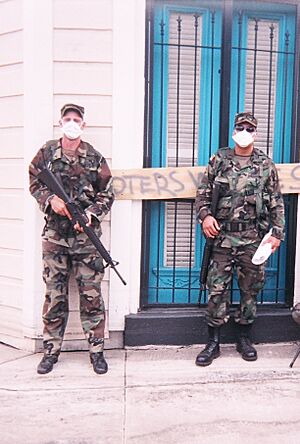Hurricane Katrina facts for kids
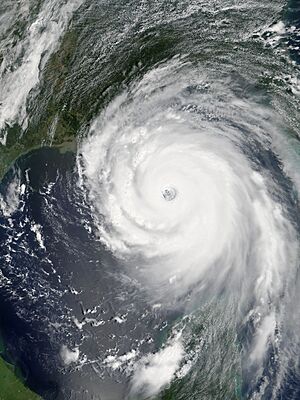
Katrina at peak intensity in the Gulf of Mexico on August 28
|
|
| Meteorological history | |
|---|---|
| Formed | August 23, 2005 |
| Extratropical | August 30, 2005 |
| Dissipated | August 31, 2005 |
| Category 5 tropical cyclone | |
| 1-minute sustained (SSHWS/NWS) | |
| Highest winds | 175 mph (280 km/h) |
| Lowest pressure | 902 mbar (hPa); 26.64 inHg |
| Overall effects | |
| Fatalities | 1,392 |
| Missing | 652 |
| Damage | $125 billion (2005 USD) (Tied as the costliest tropical cyclone on record) |
| Areas affected |
|
|
Part of the 2005 Atlantic hurricane season |
|
Hurricane Katrina was a very powerful and destructive tropical cyclone that hit the United States in August 2005. It caused about $125 billion in damage, especially in and around New Orleans, Louisiana. Katrina was one of the most expensive tropical cyclones ever recorded in the Atlantic Ocean. It was also one of the strongest hurricanes to reach the contiguous United States.
Katrina started on August 23, 2005. It grew into a tropical storm over Florida, then became a powerful Category 5 hurricane over the Gulf of Mexico. When it made landfall on August 29 near Buras-Triumph, Louisiana, it had weakened to a Category 3 hurricane.
A huge part of New Orleans, about 80%, was flooded. Many people had to leave their homes. The flooding happened because the levees and floodwalls protecting the city broke. These protection systems were built by the U.S. Army Corps of Engineers. Many groups, including federal, local, and private organizations, worked hard to rescue people and help those affected.
The way different governments responded to the disaster faced some criticism. However, groups like the United States Coast Guard (USCG) and the National Hurricane Center (NHC) were praised for their quick actions and accurate forecasts. Because of how much damage and how many lives were lost, the name 'Katrina' was officially retired in April 2006. This means no future hurricane will be named Katrina. The storm caused 1,392 deaths.
Contents
How Hurricane Katrina Formed and Moved
Hurricane Katrina began as a weak weather disturbance on August 19, 2005, near the Bahamas. It quickly grew into Tropical Storm Katrina on August 24. The storm then moved towards Florida and became a hurricane just before hitting land on August 25.
After crossing Florida, Katrina entered the Gulf of Mexico and became much stronger very quickly. On August 27, it reached Category 3 strength, becoming a major hurricane. The storm continued to grow, reaching its peak strength as a powerful Category 5 hurricane on August 28. At its strongest, Katrina had winds of 175 mph (280 km/h).
Katrina then weakened slightly before making its second landfall on August 29 near Buras-Triumph, Louisiana, as a strong Category 3 hurricane with winds of 125 mph (201 km/h). It continued inland, bringing strong winds and heavy rain to Mississippi, before finally weakening to a tropical storm and then a tropical depression. Its remnants eventually moved into eastern Canada.
Getting Ready for the Storm
Before Hurricane Katrina hit, many people and governments worked to prepare. The United States Coast Guard moved its rescue teams and aircraft to safe areas. They got ready to help people after the storm.
On August 27, President George W. Bush declared a state of emergency for parts of Louisiana, Alabama, and Mississippi. This allowed federal help to be sent quickly. Officials encouraged people to leave areas that were expected to be hit hard.
Many people living along the Gulf Coast were asked to evacuate, meaning to leave their homes for safety. About 1.2 million residents were under an evacuation order.
Weather Warnings and Forecasts
The National Hurricane Center (NHC) closely watched Katrina. On August 26, they updated their predictions, showing that the storm was heading towards the Mississippi coast and New Orleans. The National Weather Service in New Orleans warned that the area could become "uninhabitable for weeks" due to "devastating damage." Experts were very worried that Katrina's storm surge could go over the city's protective levees.
Gulf Coast Preparations
Florida's Actions
Florida Governor Jeb Bush declared a state of emergency early on. Schools and businesses closed in the Miami area. People in mobile homes or vulnerable areas were asked to evacuate. Airports also closed to keep people safe.
Alabama and Mississippi Get Ready
Alabama Governor Bob Riley also declared a state of emergency. The National Guard was called to duty in both Alabama and Mississippi. Many counties and cities issued evacuation orders, and emergency shelters were opened for those who needed a safe place to stay.
Louisiana's Evacuation Plan
Louisiana had a plan for hurricane evacuations, asking people in coastal areas to leave in phases. New Orleans Mayor Ray Nagin ordered the first-ever mandatory evacuation for the city on August 28, after Katrina became a Category 5 storm. The city also set up places like the Louisiana Superdome for people who couldn't leave. Many residents, about 80% of the greater New Orleans area, evacuated before the storm hit.
Hurricane Katrina's Impact
| Alabama | 2 |
| Florida | 14 |
| Georgia | 2 |
| Kentucky | 1 |
| Louisiana | 986–1,577* |
| Mississippi | 238 |
| Ohio | 2 |
| Total | 1,245–1,836 |
|---|---|
| Missing | 652 |
| *Includes out-of-state evacuees counted by Louisiana |
|
On August 29, 2005, Hurricane Katrina's powerful storm surge caused many breaks in the flood protection systems around New Orleans. This led to about 80% of the city being underwater. Experts later found that most of the flooding was due to failures in the city's floodwalls. The storm surge also caused huge damage along the coasts of Mississippi and Alabama.
Katrina became one of the most expensive natural disasters in U.S. history, with total damages estimated at $125 billion. It was also one of the deadliest hurricanes since the 1928 Okeechobee hurricane.
The exact number of deaths from Katrina is hard to determine, but it is known that 1,392 people died because of the storm. Most of these deaths occurred in Louisiana and Mississippi. Many people were also reported missing.
The hurricane left about three million people without electricity. Federal disaster declarations covered a huge area, almost as big as the United Kingdom. The aftermath of Katrina was described as one of the worst catastrophes in the country's history. Even years later, some coastal communities still had debris from the storm.
Impact on Bahamas and Cuba
Before reaching Florida, Katrina passed through the Bahamas as a tropical storm. It caused only minor effects there.
Even though Hurricane Katrina stayed north of Cuba, it brought strong winds and heavy rain to the western parts of the island. Some telephone and power lines were damaged, and about 8,000 people had to evacuate. A coastal town called Surgidero de Batabanó was almost completely underwater.
Impact on the United States
Florida's Experience
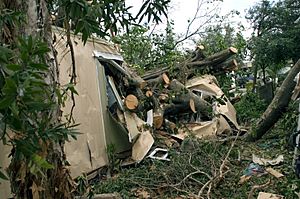
Hurricane Katrina first hit Florida on August 25. It brought heavy rainfall, causing local flooding and damaging homes. A tornado also formed in Marathon, Florida, causing damage to an airport hangar. The strong winds and rain knocked down trees and power lines, leaving 1.45 million people without electricity. The total damage in South Florida was about $523 million, and 14 people died.
The storm also affected the Florida Panhandle. High waves caused beach erosion and closed roads. There were also five tornadoes, but they did not cause major damage. About 77,000 customers lost power in this area.
Louisiana's Damage


On August 29, Katrina made landfall in Louisiana as a strong Category 3 hurricane. A significant storm surge affected the coast, with water levels rising over 14 feet (4.3 m) in some areas. Heavy rain, up to 15 inches (380 mm), also fell across eastern Louisiana.
The combination of rain and storm surge caused Lake Pontchartrain to rise, leading to major flooding along its shores. Several bridges were destroyed, including parts of the I-10 Twin Span Bridge. Nearly 900,000 people in Louisiana lost power.
Areas around Lake Pontchartrain, like St. Tammany and St. Bernard Parishes, were heavily flooded. St. Bernard Parish was flooded because levees along a navigation channel called the Mississippi River Gulf Outlet (MR-GO) broke. Many homes were damaged or destroyed in these parishes. The storm also destroyed a large amount of coastal wetlands in Louisiana.
New Orleans Flooding
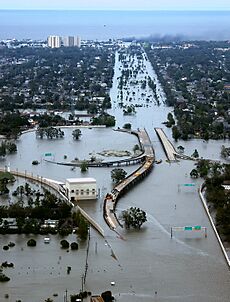
As Katrina passed, New Orleans experienced hurricane-force winds for hours. The storm's surge caused 53 breaks in the federal levee system protecting the city. This led to about 80% of New Orleans being flooded. Major levee breaks happened at the 17th Street Canal, the London Avenue Canal, and the Industrial Canal.
Most major roads into and out of the city were damaged. The Louisiana Superdome, which was sheltering many people, also suffered significant damage to its roof. The Louis Armstrong New Orleans International Airport was closed but did not flood, reopening for rescue operations soon after.
The levee breaks in New Orleans caused many deaths. Many people who could not evacuate were trapped in flooded areas.
Some of the first deaths reported were nursing home patients who died during evacuation. Many patients in hospitals were without power or fresh water for days before being evacuated.
Mississippi's Destruction
The Gulf coast of Mississippi suffered extremely severe damage from Hurricane Katrina. The storm caused 238 deaths and left 67 people missing. Bridges, boats, houses, and cars were washed far inland. All 82 counties in Mississippi were declared disaster areas.
Katrina's eye passed over Bay St. Louis and Waveland as a Category 3 hurricane. It brought a powerful 27-foot (8.2 m) storm surge that reached up to 12 miles (19 km) inland in some places. Strong winds, with gusts up to 135 mph (217 km/h), caused widespread tree damage.
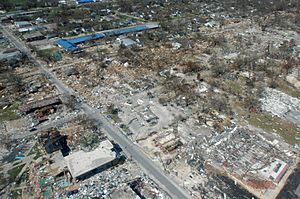
Many beachfront neighborhoods were completely destroyed. Officials estimated that 90% of structures within half a mile of the coastline were gone. More than half of the state's casinos, which were on barges, were washed hundreds of yards inland.
Several streets and bridges were washed away, including major bridges on U.S. Highway 90. The storm surge covered almost the entire lower half of Hancock County and large parts of Harrison and Jackson counties. Over 900,000 people across the state lost power.
Alabama's Challenges
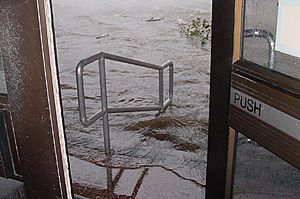
Even though Katrina made landfall to the west, Alabama experienced tropical-storm-force winds and a storm surge of 12 to 16 feet (3.7–4.9 m) around Mobile Bay. This surge caused significant flooding several miles inland. Four tornadoes were also reported.
Ships, oil rigs, and fishing piers were washed ashore along Mobile Bay. An oil rig under construction broke free and hit the Cochrane Bridge, but the bridge was not seriously damaged. Dauphin Island suffered severe damage, with many houses destroyed and a new canal cut through the island. Over 600,000 people in Alabama lost power, and two people died in a traffic accident.
Other U.S. States Affected
As Katrina moved inland, it brought heavy rains and strong winds to other states. Northern and central Georgia saw over 3 inches (76 mm) of rain and at least 18 tornadoes, causing damage to homes and farms. Two people died in Georgia.
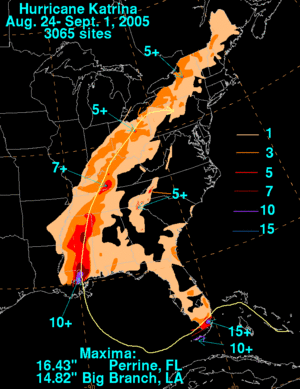
In Kentucky, heavy rainfall caused flooding. Strong winds also downed trees and power lines. The storm's remnants caused localized flooding and power outages in states like Tennessee, Ohio, West Virginia, and Pennsylvania. Two deaths occurred in Ohio due to a flood-related car accident.
Canada's Experience
In Canada, the remnants of Katrina brought heavy rainfall, over 3.94 in (100 mm), to areas between the Niagara Peninsula and the Saint Lawrence River valley. This caused severe local flooding in Quebec, forcing many homes to evacuate. Roads were washed out, leaving some communities isolated for a week.
Aftermath of Hurricane Katrina
Economic Effects
| Rank | Hurricane | Season | Damage | ||
|---|---|---|---|---|---|
| 1 | Katrina | 2005 | $108 billion | ||
| 2 | Sandy | 2012 | $71.4 billion | ||
| 3 | Ike | 2008 | $29.5 billion | ||
| 4 | Andrew | 1992 | $26.5 billion | ||
| 5 | Wilma | 2005 | $21 billion | ||
| 6 | Ivan | 2004 | $18.8 billion | ||
| 7 | Irene | 2011 | $15.6 billion | ||
| 8 | Charley | 2004 | $15.1 billion | ||
| 9 | Rita | 2005 | $12 billion | ||
| 10 | Frances | 2004 | $9.51 billion | ||
| Source: National Hurricane Center | |||||
The economic impact of Hurricane Katrina was enormous. The U.S. government sought $105 billion for repairs and rebuilding. The storm damaged or destroyed many oil platforms and closed several refineries, affecting the country's oil supply. The forestry industry in Mississippi also suffered huge losses, estimated at $5 billion.
Hundreds of thousands of people lost their jobs. Before the hurricane, the region had about one million non-farm jobs. Katrina forced over one million people to move from the Gulf Coast to other parts of the United States, making it the largest displacement in U.S. history. Cities like Houston, Texas, and Baton Rouge, Louisiana, saw large increases in their populations. By early 2006, New Orleans' population was less than half of what it was before the storm.
Environmental Effects

Katrina also had a big impact on the environment. The storm surge caused significant beach erosion, changing coastal areas. For example, on Dauphin Island, sand was moved across the island, pushing it closer to the mainland. The storm also severely damaged the Chandeleur Islands. Experts estimate that about 217 sq mi (560 km2) of land was turned into water by Hurricanes Katrina and Rita.
The lost lands were important breeding grounds for marine animals like sea turtles and various birds and fish. About 20% of the local marshes were permanently covered by water. Katrina also caused massive tree loss along the Gulf Coast, which affected the environment for years.
The storm led to oil spills from many facilities in southeastern Louisiana. While most spills were small and contained, some oil entered the environment and residential areas. For example, a spill at the Murphy Oil refinery affected 1,800 homes.
After the storm, the floodwaters covering New Orleans were pumped into Lake Pontchartrain. This process took 43 days. These waters contained a mix of dirty water, chemicals, and oil, raising concerns about harm to fish and the lake's ecosystem.
Restoring Order and Help
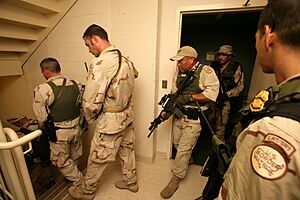
After the hurricane, some residents who remained in New Orleans faced challenges, including a breakdown of public order. People struggled to find food and water. To help restore safety, thousands of National Guard and federal troops were sent to Louisiana. Local law enforcement also worked to bring back order.
Over the first week of September, safety was gradually restored to the city. Many people were arrested for various reasons. A temporary jail was even set up in the city's main train station.
Media's Role
News reporters played a special role after Hurricane Katrina. Because most communication systems were down, reporters often became a way for victims to send messages to authorities. News channels and websites helped coordinate rescue efforts. For example, WWL-AM radio was one of the few stations still on air, providing vital emergency information to hundreds of thousands of people.
Websites, especially blogs and community journalism sites, also became very important. NOLA.com, the website for New Orleans' Times-Picayune newspaper, became a central place for news and for people to ask for help or find loved ones. Rescue teams used information from the site to guide their efforts. This showed how powerful online community efforts could be during a disaster.
In September 2022, the Associated Press updated its style guide for reporting on Katrina. It stated that reporters should always mention that "levee failures played a major role in the devastation in New Orleans."
Retirement of the Name 'Katrina'
Because of the many deaths and widespread destruction along the U.S. Gulf Coast, the name Katrina was officially retired from the Atlantic hurricane naming lists in April 2006 by the World Meteorological Organization. This means the name will never be used again for another tropical cyclone in the Atlantic. It was replaced with Katia for the 2011 Atlantic hurricane season.
Rebuilding Efforts
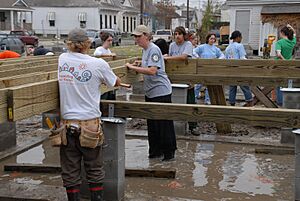
After the storm, there were huge efforts to rebuild the affected areas. The U.S. Army Corps of Engineers created a detailed report called LACPR (Louisiana Coastal Protection and Restoration). This report suggested where new levees should be built, how existing ones could be improved, and which areas might need to be rebuilt differently or have buildings raised. This plan was submitted to the U.S. Congress for future planning.
Records Set by Katrina
Katrina is tied with Hurricane Harvey (2017) as the costliest tropical cyclone ever recorded. It was also the fourth-most intense Atlantic hurricane to make landfall in the contiguous United States. Katrina was the earliest eleventh-named storm in the Atlantic until Tropical Storm Kyle surpassed it on August 14, 2020.
See also
 In Spanish: Huracán Katrina para niños
In Spanish: Huracán Katrina para niños
- List of Category 5 Atlantic hurricanes
- List of Florida hurricanes (2000–present)
- Wetlands of Louisiana
- Crescent Rising
- Hurricanes and climate change
- Hurricane Katrina in fiction
- Hurricane on the Bayou
- Reconstruction of New Orleans
- Timeline of Hurricane Katrina
- List of conspiracy theories
- List of notable media in the field of meteorology
Other similar tropical cyclones:
- Hurricane Betsy (1965) – A strong hurricane that had a similar path in the Gulf to Katrina.
- Hurricane Camille (1969) – A very powerful Category 5 hurricane that hit similar areas to Katrina.
- Hurricane Andrew (1992) - A Category 5 hurricane that devastated similar areas.
- Hurricane Rita (2005) – Another powerful hurricane that struck the Gulf Coast just a month after Katrina.
- Hurricane Harvey (2017) – A Category 4 hurricane that caused massive flooding in Texas and is tied with Katrina as the costliest tropical cyclone.
- Hurricane Laura (2020) – A Category 4 hurricane that struck Louisiana.
- Hurricane Ida (2021) – A Category 4 hurricane that made landfall in Louisiana.



